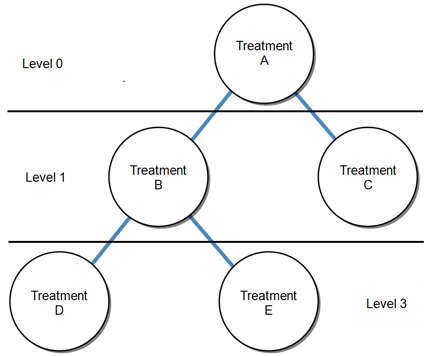How Horizons-PIT Chooses Between Treatments
Each Treatment set defines a Treatment hierarchy. A Treatment Set determines the parent-child relationships between Treatments.
Treatment Hierarchy
Treatment types are organised into hierarchies, with the most severe treatments at the top and minor treatments at the bottom, for example, reconstruct, 180 mm inlay, 50 mm inlay, surface dressing, etc. When several treatments are triggered, analysis will select the parent treatments (those which are highest in the hierarchy), for example, if 50 mm inlay and surface dressing treatments are both triggered, the surface dressing treatment is discarded.
Treatment type hierarchies can branch where subsections may require multiple treatments at the same time. A common example is a rural unclassified road, which may require an edge treatment and patching.

A Treatment that does not have a parent occupies Level 0 at the top of the hierarchy. Level 0 Treatments are usually the most severe Treatment types, in terms of Treatment effect (for example, reconstruction).
Treatments in a parent-child relationship (for example, Treatments B and D in the diagram above) are alternative Treatments to Treatment A. Therefore they cannot both be activated at the same time. Alternative Treatments differ either in terms of Treatment effect (severity) or in terms of constraints on scheme length and cost (for example, patching versus resurfacing).
If alternative Treatments are triggered at the same time, the Treatment higher up the hierarchy is chosen over one lower down.
Treatments at the same level in the hierarchy (for example, Treatments B and C on Level 1) are independent and can therefore be activated at the same time on a particular length.
It is not necessary for all the treatment types to be in the same hierarchy (although an individual treatment type cannot have more than one parent). For example, treatment types may be grouped into separate hierarchies by asset group to separate the different treatment types required for asphalt and concrete roads. In this case the treatment type is configured to be only applicable to its specific asset groups.
It is important to remember that no subsection can undergo treatment types from different hierarchies. A common error is to group roads into the “asphalt”, “concrete” and “unknown” asset groups and for treatment types to be defined for “asphalt” and “unknown” and for “concrete” and “unknown”. Roads in the “unknown” asset group can then have concrete and asphalt treatments triggered simultaneously.